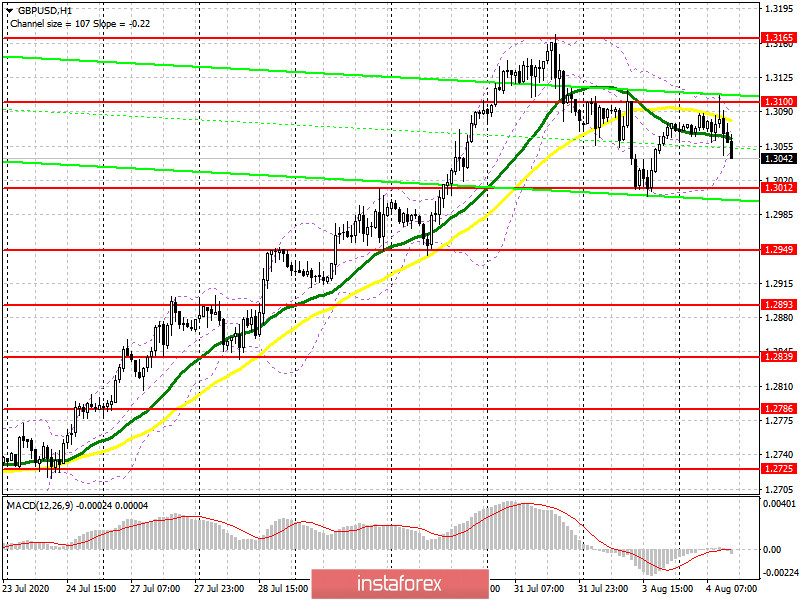To open long positions on GBPUSD, you need:
The lack of fundamental statistics and confidence of buyers again led to the formation of a sell signal for the British pound in the first half of the day from the level of 1.3100. An unsuccessful attempt to break above this range formed a good entry point into short positions, which is clearly visible on the 5-minute chart. I paid attention to this probability in my morning forecast and recommended selling the pound. At the moment, the task of the bulls is to protect the support of 1.3012, but only the formation of a false breakout there will be a signal to open long positions on the pound in the hope of returning to the morning resistance of 1.3100. If there is no activity on the part of the bulls at the level of 1.3012, it is best to postpone the opening of long positions until the update of the minimum of 1.2949 in the expectation of a correction of 30-40 points within the day. It is also an important task for buyers to return the resistance of 1.3100, since only above this level the bullish trend for the pound will return to normal and continue with a new force, opening the way to the highs of 1.3165 and 1.3228.

To open short positions on GBPUSD, you need:
Bears fully coped with their task and continued the downward correction of the pound, and to be more precise, did not allow buyers to develop a new bullish momentum for the pound. In the second half, the sellers' goal is to retest the support of 1.3012, since only a breakdown and consolidation below this level will open the way to new lows in the area of 1.2949 and 1.2893, where I recommend fixing the profits. However, such an active movement of the pound down will require very good fundamental data on the US economy, the release of which is not scheduled for this afternoon. If the bulls try to bring the market back under their control, short positions can still be returned if a false breakout is formed in the resistance area of 1.3100 or sell the pound to rebound from the weekly high in the area of 1.3165, counting on a correction of 30-40 points within the day.

Signals of indicators:
Moving averages
Trading is just below the 30 and 50 daily averages, which indicates a further downward correction for the pound.
Note: The period and prices of moving averages are considered by the author on the hourly chart H1 and differ from the general definition of the classic daily moving averages on the daily chart D1.
Bollinger Bands
In case of growth, the upper limit of the indicator in the area of 1.3110 will act as a resistance. A break in the lower border at 1.3030 will definitely increase the pressure on the British pound.
Description of indicators
- Moving average (moving average determines the current trend by smoothing out volatility and noise). Period 50. The graph is marked in yellow.
- Moving average (moving average determines the current trend by smoothing out volatility and noise). Period 30. The graph is marked in green.
- MACD indicator (Moving Average Convergence / Divergence - moving average convergence / divergence) Fast EMA period 12. Slow EMA period 26. SMA period 9
- Bollinger Bands (Bollinger Bands). Period 20
- Non-profit traders are speculators, such as individual traders, hedge funds, and large institutions that use the futures market for speculative purposes and meet certain requirements.
- Long non-commercial positions represent the total long open position of non-commercial traders.
- Short non-commercial positions represent the total short open position of non-commercial traders.
- Total non-commercial net position is the difference between short and long positions of non-commercial traders.





















